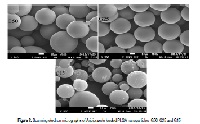Aripiprazole loaded PLGA nanoparticles for controlled release studies: Effect of Co-polymer ratio
Keywords:
PLGA Nanoparticles, Co-polymer Ratio, Controlled drug deliveryAbstract
Poly (lactic-co-glycolic acid) nanoparticles loaded with Aripiprazole has been developed as a new therapeutic strategy to achieve its controlled release profile suitable for parenteral administration. Nanospheres composed of different lactic/glycolic acid ratios and drug compositions were synthesized and loaded with Aripiprazole by emulsion/solvent evaporation method and subsequently characterized by particle-size distribution, scanning electron microscopy, encapsulation efficiency and inăvitro drug release studies. Specific drug-polymer interactions are engineered by optimizing the lactide to glycolide ratio (L:G ratio) and including specific polymer hydrophobicity
References
. Langer R. Drug delivery and
targeting. Nature 1998; 392:5ă10.
. Woo BH, Jiang G, Yeong W,
DeLuca PP. Preparation and
characterization of a composite
PLGA and poly(acryloyl
hydroxyethyl starch) microsphere
system for protein delivery. Pharm.
Res. 2001; 18:1600-1606.
. Dong HN, Youna YS, Leea SD,
Sonb MW, Kimb WB, DeLucac PP,
leea KC. Monitoring of peptide
acylation inside degrading PLGA
microspheres by capillary
electrophoresis and MALDI-TOF
mass spectrometry. J. Control.
Release 2003; 92:291-299.
. Mu L, Feng SS. A novel controlled
release formulation for the
anticancer drug paclitaxel (Taxol):
PLGA nanoparticles containing
vitamin E TPGS. J. Control. Release
; 86:33-48.
. Okada H, Toguchi H. Biodegradable
microspheres in drug delivery. Crit.
Rev. Ther. Drug Carrier Syst. 1995;
:1-99.
. Barratt G. Colloidal drug
carriers: achievements and
perspectives. Cell. Mol. Life Sci.
; 60:21-37.
. Lam XM, Duenas ET, Daugherty AL,
Levin N, Cleland JL. Sustained
release of recombinant human
insulin-like growth factor-1 for
treatment of diabetes. J. Control.
Release 2000;67: 281-292.
. Cohen S, Yoshioka T, Lucarelli M,
Hwang LH, Langer R. Controlled
delivery systems for proteins based
on poly(lactic/glycolic acid)
microspheres. Pharm. Res.
;8:713-720.
. Whittlesey KJ, Shea LD. Delivery
systems for small molecule drugs,
proteins, and DNA: the
neuroscience/biomaterial interface.
Exp. Neurol. 2004; 190: 1-16.
. Lagarce F, Faisant N, Desfontis JC,
Marescaux L, Gauiter F, Richerd J.
Baclofen-loaded microspheres in gel
suspensions for intrathecal
drugdelivery: In vitro and in
vivo evaluation. Eur. J. Pharm.
Biopharm. 2005;61: 171-180.
. Shive MS, Anderson JM.
Biodegradation and biocompatibility
of PLA and PLGA microspheres.
Adv. Drug Deliv. Rev. 1997;28: 5-
. Gabor F, Ertl B, Wirth M, Mallinger
R. Ketoprofen-poly(D,L-lactic-coglycolic acid) microspheres:
influence of manufacturing
parameters and type of polymer on
the release characteristics. J.
Microencapsul. 1999;16: 1-12.
. Gavin MC, Goa KL. Aripiprazole.
CNS Drugs 2002;16: 779-786.
. Burris KD, Moiski TF. Aripiprazole, a
novel antipsychotic, is a high-affinity
partial agonist at human dopamine
D2 receptors.J. Pharmacol. Exp.
Ther. 2002;302: 381-389.
. Goodnuck PJ, Jerry JM.
Aripiprazole: profile on efficacy and
safety. Expert Opinion on
Pharmacotherapy 2002;12: 1773-
. Nidhin M, Indumathy R, Sreeram K,
Nair B. Synthesis of iron oxide
nanoparticles of narrow size
distribution on polysaccharide
templates. Bull. Mater. Sci. 2008;31:
-96.
. Panyam J, Williams D, Dash A,
Leslie-Pelecky D, Labbasetwar V.
Solid-state solubility influences
encapsulation and release of
hydrophobic drugs from PLGA/PLA
nanoparticles. J. Pharm. Sci.
;93: 1804-1814.
. Kosmidis K, Rinaki E, Argyrakis P,
Macheras P. Analysis of Case II
drug transport with radial and axial
release from cylinders. Int. J.
Pharm. 2003;254: 183-188.
. Ritger PL, Peppas NA. A Simple
Equation for Description of Solute
Release. I. Fickian and non-Fickian
Release from Non-Swellable
Devices in the Form of Slabs,
Spheres, Cylinders or Discs. J.
Control. Release 1987;5: 23-36.
. Ritger PL, Peppas NA. A Simple
Equation for Description of Solute
Release. II. Fickian and Anomalous
Release from Swellable Devices. J.
Control. Release 1987;5: 37-42.
. Huang X, Brazel CS. On the
importance and mechanisms of
burst release in matrix-controlled
drug delivery systems. J. Control.
Release 2001;73: 121-136





